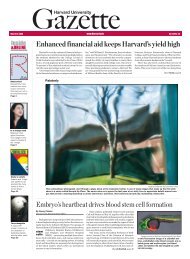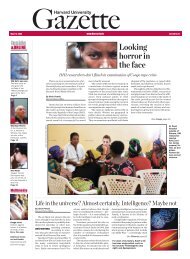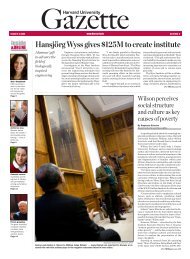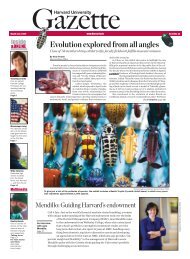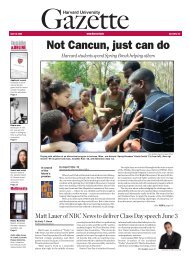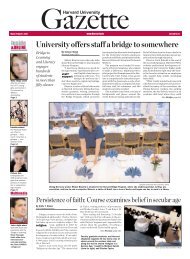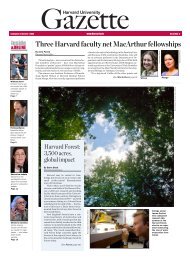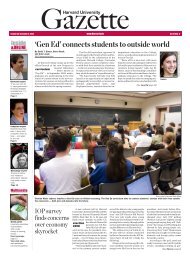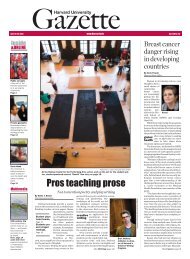Harvard University Gazette December 4-10, 2008 - Harvard News ...
Harvard University Gazette December 4-10, 2008 - Harvard News ...
Harvard University Gazette December 4-10, 2008 - Harvard News ...
You also want an ePaper? Increase the reach of your titles
YUMPU automatically turns print PDFs into web optimized ePapers that Google loves.
<strong>December</strong> 4-<strong>10</strong>, <strong>2008</strong> <strong>Harvard</strong> <strong>University</strong> <strong>Gazette</strong>/ 15<br />
Nigerian lawyer is a champion of women<br />
By Corydon Ireland<br />
<strong>Harvard</strong> <strong>News</strong> Office<br />
In 2002, a young Nigerian woman by the<br />
name of Amina Lawal — pregnant and unmarried<br />
— was tried for adultery under<br />
Shariah, Islam’s traditional law. She was<br />
sentenced to be stoned to death, a fate that<br />
briefly riveted the attention of media<br />
worldwide.<br />
But the next year, Lawal was free —<br />
law<br />
Radcliffe Fellow<br />
Hauwa Ibrahim<br />
(right), the first<br />
female lawyer in<br />
northern Nigeria’s<br />
predominantly<br />
Muslim Gombe region,<br />
talks about<br />
her battles with<br />
the excesses of<br />
Shariah. African<br />
Studies Professor<br />
Caroline Elkins<br />
(below, right)<br />
chats with<br />
Ibrahim before introducing<br />
her to<br />
the audience.<br />
thanks to a legal defense assembled<br />
by Hauwa Ibrahim, the first female<br />
lawyer in northern Nigeria’s predominantly<br />
Muslim Gombe region.<br />
The case set precedent — important in<br />
an Africa where Shariah is increasingly<br />
being adopted. Lawal would have been the<br />
first woman executed by stoning since parts<br />
ofNigeria took on Shariah penal law in 1999.<br />
Once one woman is stoned to death,<br />
said Ibrahim to a <strong>Harvard</strong> audience recently,<br />
“it would never stop.”<br />
A Radcliffe Fellow this year, Ibrahim<br />
gained legal success by using Shariah law to<br />
fight Shariah penalties. It entailed high personal<br />
risk, which made having a plan of escape<br />
— that is, a way to get out of court alive<br />
— necessary in every legal case.<br />
“I am told it is dangerous,” Ibrahim said<br />
of a visit she will make to Somalia this<br />
month to investigate a case, but “no one<br />
should be stoned to death.”<br />
The Lawal case also propelled the veteran<br />
Nigerian lawyer into the limelight, where<br />
she remains. Ibrahim, among many other<br />
honors, was a Yale World Fellow, became an<br />
honorary citizen of Paris, and in 2005<br />
earned the European Parliament’s prestigious<br />
Sakharov Prize for Freedom of<br />
Thought. By that time she had already taken<br />
on 90 mostly pro bono cases challenging<br />
Shariah law. (The total today: around 150.)<br />
In her Radcliffe year, she is writing a<br />
book on the Shariah penal code and how it<br />
relates to human rights and to gender and<br />
justice. Ibrahim — forceful, funny, and resplendent<br />
in a pale blue head covering and<br />
a silky white cape — shared a draft of her<br />
thoughts last week (Nov. 24) to a full house<br />
of 250 rapt listeners at the Radcliffe Gymnasium.<br />
“I became educated by accident,” she<br />
said of her upbringing in a remote Gombe<br />
village, where to this day there is no running<br />
water, electricity, or roads — and<br />
where girls are not expected to go beyond<br />
elementary school.<br />
Photos Kris Snibbe/<strong>Harvard</strong> <strong>News</strong> Office<br />
“Stone Her to Death Why Defending<br />
Women Within Shariah Courts” was this<br />
year’s Rama S. Mehta lecture, a tradition<br />
since 1981 at the Radcliffe Institute for Advanced<br />
Study. The periodic talk, intended<br />
to spotlight a distinguished woman, was<br />
established by <strong>Harvard</strong> economist, author,<br />
and professor John Kenneth Galbraith<br />
(who died in 2006) and his wife, Catherine<br />
Atwater Galbraith.<br />
Ibrahim called her native country “vast,<br />
wide, and rich” — but troubled by poverty,<br />
political corruption, ethnic unrest, and a religious<br />
divide. Less than <strong>10</strong> years ago, after<br />
throwing off decades of military rule, most<br />
counties in the Muslim north adopted Shariah<br />
for both civil and criminal cases.<br />
(See Ibrahim, next page)<br />
At GSD, UPenn’s<br />
Thomas Sugrue<br />
talks about<br />
‘civil rights and<br />
the metropolis’<br />
By Ruth Walker<br />
Special to the <strong>Harvard</strong> <strong>News</strong> Office<br />
For the first time in a generation, urban<br />
policy is back on the national agenda.<br />
Advocates for the nation’s cities have<br />
been thrilled by the announcement that the<br />
Obama administration will include a White<br />
House Office of Urban Policy.<br />
This is “electrifying news,” Thomas Sugrue<br />
told his audience at the <strong>Harvard</strong> Graduate<br />
School of Design’s (GSD) Piper Auditorium<br />
Nov. 25. Sugrue is the Edmund J. and<br />
Louise W. Kahn Professor of History and<br />
urban<br />
planning<br />
Sociology at the <strong>University</strong><br />
of Pennsylvania and a Bancroft<br />
Prize-winning chronicler<br />
of race and racial discrimination in<br />
mid-20th century American cities. His latest<br />
book is “Sweet Land of Liberty: The Forgotten<br />
Struggle for Civil Rights in the<br />
North.”<br />
He was at the GSD to speak on the topic<br />
“Planning for Justice: Civil Rights, Black<br />
Power, and the Metropolis.”<br />
In his lecture, Sugrue expressed the hope<br />
that the new administration would learn<br />
from the failures of the last effort at comprehensive<br />
urban policy — from the mid-<br />
1960s to the mid-1970s. These failures, Sugrue<br />
said, resulted from what he called a “policy<br />
mismatch” — a reliance on small-scale<br />
local solutions to problems whose causes<br />
were ultimately regional, national, or even<br />
global.<br />
Sugrue identified two urban policy<br />
camps during the 1960s and ’70s — what he<br />
called “activist planners” and “community<br />
activists.” “These two traditions coexisted<br />
and interacted only with some mistrust,” he<br />
noted, adding that they were “often at loggerheads.”<br />
The activist planners had affinities to integration<br />
and to post-New Deal modernism.<br />
And they responded to a “hopeful new reality”:<br />
the increased numbers of white<br />
Americans who were willing to have black<br />
neighbors — or so they told opinion researchers,<br />
anyway.<br />
The activist planners pushed for zoning<br />
changes, sought to scatter public housing<br />
outside the inner city, and tried to get the<br />
lines of school districts redrawn. Their<br />
goals were “de-ghettoization” of the black<br />
community and the integration of metropolitan<br />
America.<br />
The community activists, on the other<br />
hand, were aligned with the black power<br />
movement. They were “oriented to process,<br />
not outcome,” Sugrue said. “Participatory<br />
politics were an end in themselves.” These<br />
activists believed in bottom-up planning.<br />
The two camps “had widely divergent<br />
views of community itself,” Sugrue said,<br />
adding that “community” was a term that<br />
came into use in a particular sense in the<br />
1960s.<br />
For the activist planners, community<br />
was seen as inherently exclusionary, tied to<br />
the “spatial isolation of groups” and the delineation<br />
of boundaries.<br />
Community activists, on the other hand,<br />
drew on deep traditions of localism and<br />
local identities, of building and reinforcing<br />
communities. Leaders such as Stokely<br />
(See Sugrue, next page)



